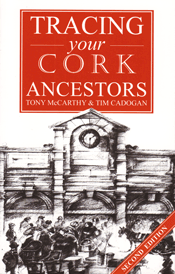Note – This volume is no longer available – As of March 17, 2016 8:50am PDT
 The very first settlers to land on the Emerald Island came ashore in what is present day Cork. Cork is Ireland’s largest county of some 3,000 square miles and has played a significant part in Ireland’s history.Though few if any records of genealogical significance will be found for these early pioneers who settled in Cork, there are plenty of more recent records to be explored. Tracing Your Cork Ancestors guides the researcher through searching the past 200 years of records with a focus on Cork families and county history.
The very first settlers to land on the Emerald Island came ashore in what is present day Cork. Cork is Ireland’s largest county of some 3,000 square miles and has played a significant part in Ireland’s history.Though few if any records of genealogical significance will be found for these early pioneers who settled in Cork, there are plenty of more recent records to be explored. Tracing Your Cork Ancestors guides the researcher through searching the past 200 years of records with a focus on Cork families and county history.
Not only is Cork county Ireland’s largest county, but it is also Ireland’s most populated county at around 480,000, or eight percent of the total population. According to the 1841 census, the Cork population in the past was closer to 850,000 people, at approximately ten percent of the total 1841 population. From the beginning, Cork has always played a major part in Ireland’s history. Cork was even the main point of emigration to North America, from the port town of Cobh (formerly Queenstown and earlier Cove). Despite its size and population, the majority of the people lived in as few as 20 principle town, with the rest living is diverse places, spread thin across the countryside. Researching records for Cork-based families is complicated by this diversity. Researching Ireland as a whole only multiplies this diversity with with noticeable, regional variation across the country’s records. This book uses Cork as an example for research. Cork specific resources are thoroughly vetted. As with anyone searching any Irish ancestor, national resources are also examined and covered, but always with an eye focused on Cork.
Resources covered include local libraries, archives, periodicals, and local histories. Chapters are ordered to provide a methodical approach to researching one’s Irish background. Chapters one to three provide a brief introduction to the topic, the book, and Irish immigration and emigration. Chapter four, possibly the most important chapter in the book, introduces the reader to Irish administrative divisions. Understanding towns, parishes, baronies and other means of dividing the civic and religious boundaries of residency across the county. The remaining chapters examine individual record types and resources for each.
Perhaps the most important thing to know about this book is it was written for a double market. This book is not specifically for North Americans or other foreigners looking into their Irish ancestry, but it is equally of importance to Irish nationals living at home with in interest in their own family’s past. Researching not just the national archives to be found in Dublin, but finding local copies and access to these records as well as those local records to be found at home in Cork county.
Tracing Your Cork Ancestors was written by Tony McCarthy & Tim Cadogan. This book was published in Ireland by Flyleaf Press. Family Roots Publishing is now importing Flyleaf Press books, currently stocking nine great titles. A few of these titles can only by found in the U.S. at Family Roots Publishing. Find a copy of Tracing Your Cork Ancestors at Family Roots Publishing; Item #: FLP007, On Sale for 50% off while supplies last- $10.98 – Reg. Price: $21.95.
Table of Contents
Tables and Illustration
Preface to Second Edition
Chapter 1. Introduction
Chapter 2. Preliminaries
Chapter 3. Emigration & Emigration Sources
Chapter 4. Administrative Divisions
Chapter 5. Censuses
Chapter 6. Civil Registration
Chapter 7. Griffith’s Valuation
Chapter 8. Tithe Applotment Books
Chapter 9. Catholic Parish Records
Chapter 10. Church of Ireland Parish Records
Chapter 11. Commercial & Postal Directions
Chapter 12. Newspapers
Chapter 13. Records of the Graveyard
Chapter 14. Electoral Lists
Chapter 15. Occupational Sources
Chapter 16. Family Histories
Chapter 17. Miscellaneous Sources
Chapter 18. Researching in Cork
Chapter 19. Researching in Dublin
Chapter 20. Useful Information
Index